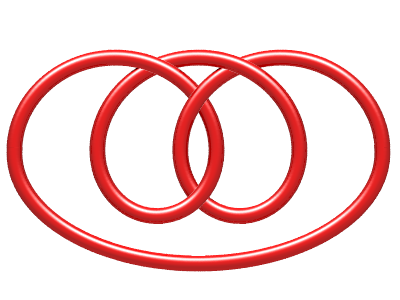FIGURE-EIGHT KNOT





| next curve | previous curve | 2D curves | 3D curves | surfaces | fractals | polyhedra |
FIGURE-EIGHT KNOT





| The rope knot which, by connecting the two free blades, gives the mathematical figure-eight knot is indeed shaped like an eight. |  |
| However, the opposite knot is equivalent to the figure-eight knot; therefore, it could also have been called "heart knot"! |
 |
Here are, in order, the equations of the first 4 representations in the header:
 |
 |
 |
 |
 |
| Homemade representation based on a lemniscate
of Gerono developed in space, the ends then being connected by a Bézier
curve.
Cartesian parametrization: |
Paul
Bourke's representation, based on an epitrochoid
with q = 2 and k = 5 .
Cartesian parametrization:  . . |
Rohit
Chaudhary's representation:
|
Representation based on a trochoid with d/R = 6, connected by an arch of ellipse. | Representation based on the cylindrical
sine wave |
| One of the geodesic line of the oblate spheroid forms an elegant 3D representation of the figure-eight knot, with axis of symmetry. |  |
| Opposite, drawings by G. K. Francis (a topological picture book) showing the passages between the various representations of the figure-eight knot. |  |
The figure-eight knot is one of the "Turk's
heads".
See also the associated Seifert
surface.
See more details on the website knot
atlas.

Figure-eight knot by Alain Esculier |

Figure-eight knot on a stained-glass of the Chateau de Blois.
|

Mongolian frieze: infinite sum of figure-eight knots (Batsukh Bold,
Mongolian national ornaments).
| next curve | previous curve | 2D curves | 3D curves | surfaces | fractals | polyhedra |
© Robert FERRÉOL 2020